Josh Newey’s Review (PS3)
In the past few years, Platinum Games have displayed a knack for fast-paced action titles that would threaten to get repetitive if their running time weren’t so short. The bloody violence and interesting art style of Mad World was entertaining for a while, but even before my incredibly brief playthrough was over, the jokey commentary by Greg Proops and John DiMaggio really started to grate on my nerves. The sexy style and gorgeous visuals of Bayonetta kept my attention rapt for a bit longer, but even a barely-there outfit made purely out of hair could keep me interested for only so long.
By the time I saw all of the amazing Vanquish previews, I couldn’t help but ask myself: Is Shinji Mikami’s latest going to be on the same boat? I know that Platinum Games can produce a polished title that’s exciting to play and absolutely gorgeous to look at. But can they produce something worth more than six or seven hours of my time?
Well, the answer is mostly yes. And just a little bit no. Hear me out.
Let me get this out of the way immediately: Vanquish is one of the most intense experiences I’ve ever had with the action genre. Almost every moment of this game is packed to the gills with bullets, explosions, and enemies from every angle imaginable. There were a few times that I’d finish a massive battle with a hugely satisfying sigh of relief. I remember a lot of people complaining that they couldn’t handle Dead Space’s stressful gameplay for more than a half hour at a time, and I had a similar experience with Vanquish. While I didn’t want to put the game down, I did find myself noticeably tense after some of the most relentless battles in the latter half of the game, enough so that I was begging for a bit more downtime before the next insane bout of combat. Vanquish only gives you a breather once or twice in the entire campaign, so when it does come, it feels incredibly incongruous with the rest of the game.
Adding to that adrenaline pumping intensity is one of Vanquish’s most touted additions – the slide mechanic. Instead of the standard dash command you’d expect from most modern action games, Vanquish gives you the ability to slide along the ground with rocket speed, allowing you to duck under low ceilings, glide up to enemies, or even slow down time to dodge bullets or take out multiple foes in seconds. This clever little idea is nothing revolutionary, but it does add a bit of entertainingly speedy flare to a type of gameplay that hasn’t had a whole lot of innovation in some time.
The most satisfying element of this addition is its use as a charging technique. If you attach melee attacks to the slide, you can rocket up to an enemy, jump-kick them into the air, slow down time, and blast away three more enemies before you hit the ground. I quickly became addicted to this technique. It’s extremely effective even with some of the strongest enemies in the game, making one of the most commonly useless types of attacks strategically essential. Adding to the excitement is the gorgeously rendered character animations, making every attack look deliberate, bad-ass, and appropriately visceral.
This is not to say that this clever little idea isn’t without its flaws. The sliding technique is almost too fast, and can thus be a little touchy to control at first. Slowing down time almost stops the trajectory of bullets, so I occasionally found myself jetting directly into a wave of enemy fire I didn’t know existed. Perhaps the most irritating flaw is the fact that your ability to melee and your ability to slide deplete the same meter. If you slide up to melee somebody, you are stuck with whatever position you land in. Your ability to slide away will be depleted, and since you can’t really run away, good luck finding cover from any other enemies that might be around you once you land.
Beyond the sliding mechanic, it becomes incredibly hard not to conjure thoughts of Gears of War (yes, I’m bringing that up. Forgive me). That “stop and pop” gameplay that made the aforementioned title so successful is also what makes Vanquish work so well. Little differences here and there help to set Vanquish apart, like your (rather useless) ability to light a cigarette and flick it out to distract enemy fire, or the reduced emphasis on healing teammates. However, the key difference is fluid, relentless speed. Instead of being weighed down by tire-sized muscles and massive guns, our hero is sleek, profoundly Japanese in style, and faster than most anything else onscreen. The villains are not lumbering monsters, but sleek, swiftly moving robots who can charge you before you even know they are there. Unfortunately, that streamlined style does not always extend to their A.I. While most enemies are extremely evasive and relatively intelligent, I would occasionally stumble upon one that would storm my cover and not even attack me. These instances were rare, but it was noticeably distracting every time it happened.
The similarities to GOW don’t stop there. The most glaring offense comes with the gruff, perpetually and needlessly angry character Lt. Col. Robert Burns, who is at your side for the entirety of the game. Burns is so blatantly ripped from modern American action games that I started to hope that his persona and painfully goofy one-liners (“Let’s shove some tungsten up this tunnel’s ass!!”) were a pointed parody of the cliché American action game hero.
As I went deeper into the game’s “story” however, my naïve denial was torn away. Everything about the characters and plot line of Vanquish is a terribly bland and hackneyed, from the mandatory skirt shots of the hot chick at home base, to Sam Gideon’s obsession with a single dramatic drag on a cigarette, to the scant story about an over-populated, under-nourished future blah blah blah. Everything about Vanquish smacks of Japanese developers imitating American styles. What results is a sea of clichés so tired that any attempt to take it seriously inevitably results in agonizing frustration. Considering how exciting and polished the gameplay is, it’s really disappointing that they couldn’t put the same kind of effort into creating some interesting context.
As you’d expect from Platinum Games, Vanquish’s visuals are nothing short of stunning. I was in awe of some of the shrapnel-strewn environments, whose sheer scope and graphical detail helped to add weight to the epic theme that the title was going for. Some of the largest enemies (including one skyscraper-sized walking turret) are simply amazing to look at, and never once do you get the feeling that the visuals are struggling to keep up with the endless onscreen action. My only gripe is how many of the enemies and environments are painted with the same shades of grey. There were even a few moments where I had some minor difficulty with enemies blending in too much with their surroundings, making them a bit harder to target. Thankfully, a couple of the later stages change up the motif significantly, adding a bit of lush greenery to the background. By the time I got there, I was overdosing on the sheen of metal.
Vanquish’s campaign is pretty brief – most could burn through it in 6-8 hours. Extra missions are available once each Act is beaten, but these serve as little more than padding without the context of a story. Seeing as how the game has no multiplayer, a lot of people will probably cry foul at this seemingly slim experience. To be honest, I don’t see Vanquish working any other way. I am incredibly satisfied with the campaign I played, and felt that the story had run its course. Unlike Mad World and Bayonetta, though, Vanquish is a game that I immediately want to replay. There’s enough variety and excitement to the gameplay that I am able to withstand some the game’s most repetitive qualities to get to its more satisfying innards.
After finishing Vanquish, it’s easy to see that Shinji Mikami wasn’t looking to create anything new as much as he was trying to send a stale corner of gaming off onto a new tangent. Clever little quirks like the sliding technique help to freshen up the action model to something new that’s both viscerally and visually exciting, even if a bit messy. It’s just a shame that the story and characters weren’t given the same attention. Despite its problems, Vanquish is a taut and entertaining title that’s sure to whet the appetite of any shooter fan that’s grown tired of the meandering meatheads of some recent titles.
B+
Alexander Sargeant’s Review
Let’s get this out of the way to start with; there is a single unlockable difficulty, and six unlockable challenges that award nothing on completion. Along with the main campaign, that is the entirety of content you will be getting for your money. This is important.
The mileage of all this depends entirely on you. The story of Sam Gideon’s assault on a city in space isn’t incredibly gripping, but it feels grand enough to be exciting in its own right. The opening cinematic sets the scene pretty succinctly, as people are literally boiled in their own skin by a microwave cannon and the city of San Francisco is obliterated, providing plenty enough motivation for some old fashioned revenge. The plot is wafer-thin after that, but for a game where the counter-attack plot is the exact same one used for Gradius or Contra that’s to be expected.
A combination of subtle streaming and character banter keeps the experience tightly constructed from one moment to the next, seamlessly moving the player through the game. The characters are also incredibly likeable, as Sam and Burns provide a fun dichotomy throughout as Sam’s optimism is powered by his youthful arrogance and high-powered suit while Burn’s old grizzled veteran attitude and visible battle fatigue reprimands both action and inaction on Sam’s part while at the same time doing the wrong things for what he believes are the right reasons. Elena also fills in the plot exposition between levels, and a number of cut scenes round out the experience rather well.
The suit is obviously the focus of these scenes as well as the minute-to-minute combat, and the game does an incredible job of making you feel that kind of power. Dodging is incredibly responsive, allowing you to evade attacks quickly and more importantly reliably. I actually turned up the sensitivity for the camera to better exploit the suit’s slow-motion system, which allows you to alter your perception of time and score accurate and powerful hits on the opponent’s key systems without fear of reprisal. It also of course allows you to dash incredible distances at a staggering speed. What I most like about the system is that all your actions chain together incredibly fluidly. Thigh-high walls provide decent cover from the robot legion to fire from, but you can push forwards and leap it to gain quick height advantage. However, if you decide to aim mid leap the slow-motion kicks in, allowing you much more time to deliver swift justice and cut a path through the enemy resistance. That means by the time you’ve leapt over the cover, you can then just boost right through the path you just created high-velocity machine gun fire.
To talk more on the combat, there are plenty of enemy types to get accustomed to. The repetition of the main red robots is mitigated by the sheer amount of them that can charge you at any time. In the challenge mode this could be as many as twenty or more at once, and that they’re easy to destroy means you can chain together a fast amount of kills in a short space of time. The less common enemies are a lot more exciting to fight however, and they really play into the different weapon’s strengths as well. The shotgun for instance has a low total ammo count, but an incredible stopping power than can kick the variety of large Romonov units onto their ass, something quite necessary when they’re charging you with an instant-kill drill. Not all weapons work particularly well on the offset, but that’s where the upgrading comes into play.
Throughout the campaign if you pick up a green upgrade cube it’ll permanently upgrade a weapon in your set, losing a fragment of its level anytime you die. Levels can also be gained if you pick up another copy of the weapon while you’re already stocked fully with that ammo type, which provides an interesting if slightly clumsy dynamic of choosing which weapon you want to use. Rocket Launchers are a great choice to get out of any tough situation, but keeping one in your inventory and constantly stocking it up with levels could make all the difference when confronted with something especially tough. Not that any of that will matter on GOD HARD mode, as the upgrades are taken away from you, but while they’re there they do a great job of taking away the less enjoyable elements of the guns you don’t usually enjoy using. The lock-on laser when capable of picking up more than four targets at once can make short work of almost any light infantry.
Being a contra-like third-person high-paced action shooter you would expect a large amount of bosses and adversaries at large to fight. Surprisingly, there actually aren’t that many. Enemy variety is decent, as they throw the toughest foes at you just infrequently enough that you still won’t quite know how to deal with them yet. They also all look gorgeous, and at large the game offers an outstanding level of presentation, if with a slightly forgettable soundtrack. The massive transforming Argus machines could be some player’s highlights, but set-pieces include a high-speed train ride where you battle enemies riding another train that sometimes is directly above you (a bad time to use grenades I might add) and one truly outstanding encounter with an enemy called ‘Crystal Viper’. This first shows up suddenly in one of the regular enemy spawns, and it quickly becomes apparent that it’s unlike anything you’ve fought before. It fights in the form of a human, with a tough crystal exterior that makes penetrating its core a seemingly impossible task. He also slices any of your comrades that gets in his way instantly in half, and is truly terrifying to encounter whenever he rears his head.
While I find myself going back to some of these grand encounters, I think the real failing of this game lies in the high score rankings. Allegedly, the longevity of the game is to be found in trying to earn the highest score you can in each area, but there doesn’t actually seem to be that many ways to increase your score. Shoot ‘em ups offer a high degree of versatility in scoring, as you’ll find it quite difficult to beat every enemy in every zone, and generally there’s another mechanic in play to earn you bonus points like chaining kills or grazing bullets. Nothing like that has been implemented in Vanquish. You’re awarded bonus points for headshots, a flat-rate bonus for finishing a stage fast enough and you’re deducted points for deaths but that seems to be about the only things you can do to ensure you score well. Vanquish doesn’t even grade your performance, so only comparing your 7950 points against your peers can you have any rough idea of your skills. Again, there are also no unlockable bonuses or rewards for scoring high by bragging rights, which would be fine if there was actually an interesting mechanic to facilitate scoring highly.
It’s this one aspect of the game that truly has me stumped at the end. It isn’t so much short as it is truncated, although the conclusion does leave a sequel more than likely at the expense of a dissatisfactory climax, as I get the feeling the scoring mechanic was introduced half-heartedly due to length concerns. I think as it is, it is a great shooter with a real sense of visceral combat that I just don’t experience in a lot of western shooters. More importantly, this is a third person shooter out of Japan that’s created a core experience that’s this well accomplished, which is absolutely staggering as routinely I haven’t seen that many attempts outside of the lack luster Lost Planet. It’s just it also shows interest in making the game better than it is without actually going that far. The bosses are so good that I want there to be more. The scoring mechanic could just have a chain gauge added or a melee multiplier to make high-risk situations in a cover based shooter that much more rewarding. The difficulty selection could’ve been implemented dynamically, so the faster and better you perform, the tougher the enemies become and the faster you need to be to survive.
Vanquish is undoubtedly one of the finest most well balanced third-person shooters I’ve played in a very long time made all the more impressive with the, let’s say ‘streamlined’ package. Part of me just wishes that wasn’t all it was happy being.
Vanq-wishes aside, this is Platinum Games proving once again that with just 6-8 hours of your time they can give you a game at the top of its genre. B+

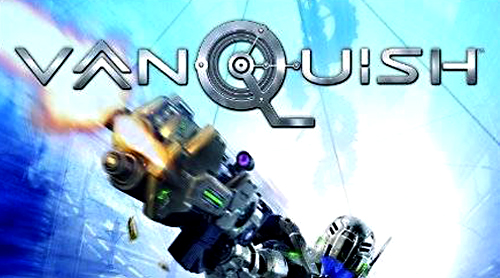
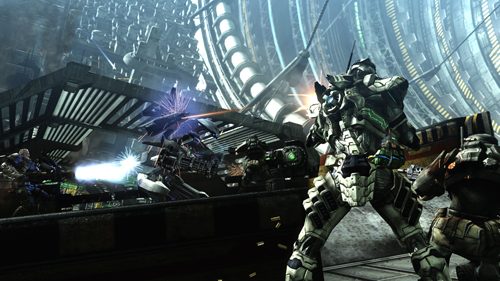
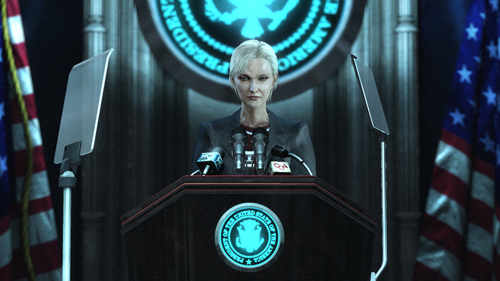
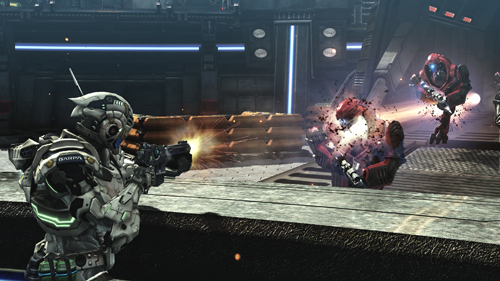
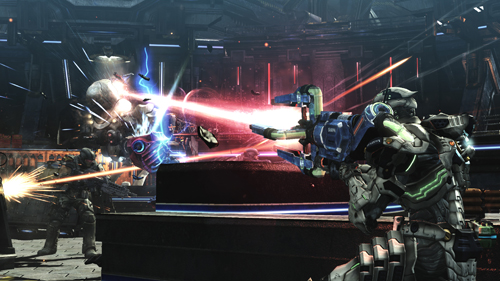
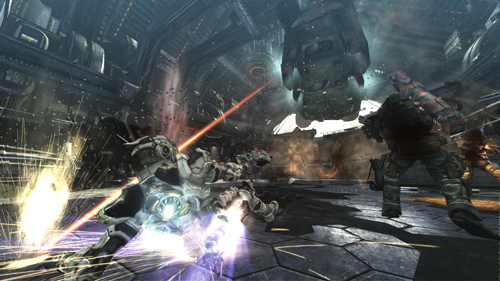
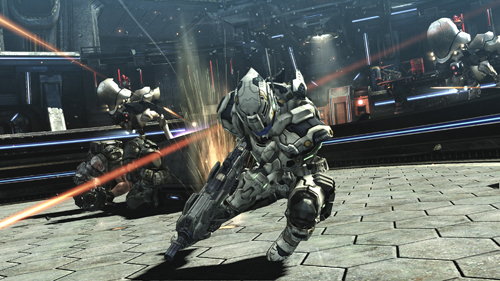
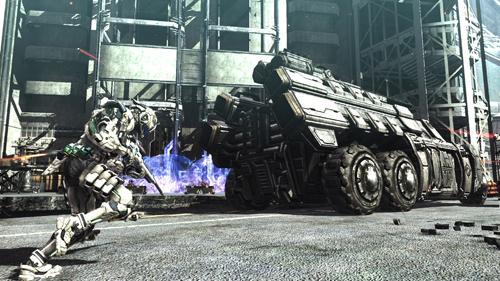
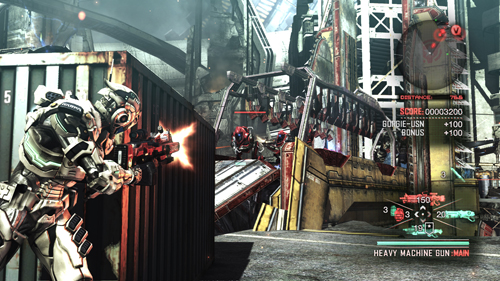
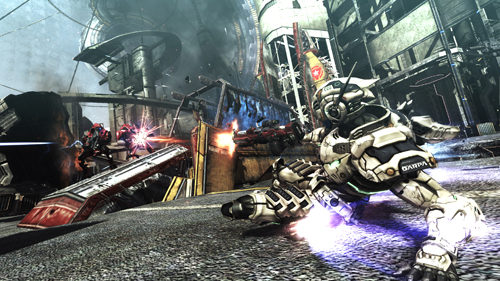
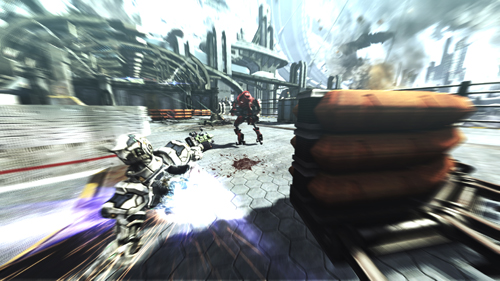

I’m not sure whether I should get this or not. I’ve grown ridiculously tired of 3rd-person action shooters, like GOW. And I don’t know if Vanquish’s sway away from the typical action genre will change my feelings. Maybe I’ll try out the demo…
Vanquish has some really impressive moments and I do think it’s worth checking out. I really liked the demo but after playing the entire campaign the game just gets better and better after the demo’s segment. I don’t really like GOW but I did like Vanquish if that means anything.
I think the 4-5 hour length should be thought about though. It didn’t bother me but if you only have $60 in your pocket and you’re not one to play a game several times trying to perfect your technique you might feel a little short handed.
Great reviews. I’ll have to get this game eventually, I already have a huge backlog right now.